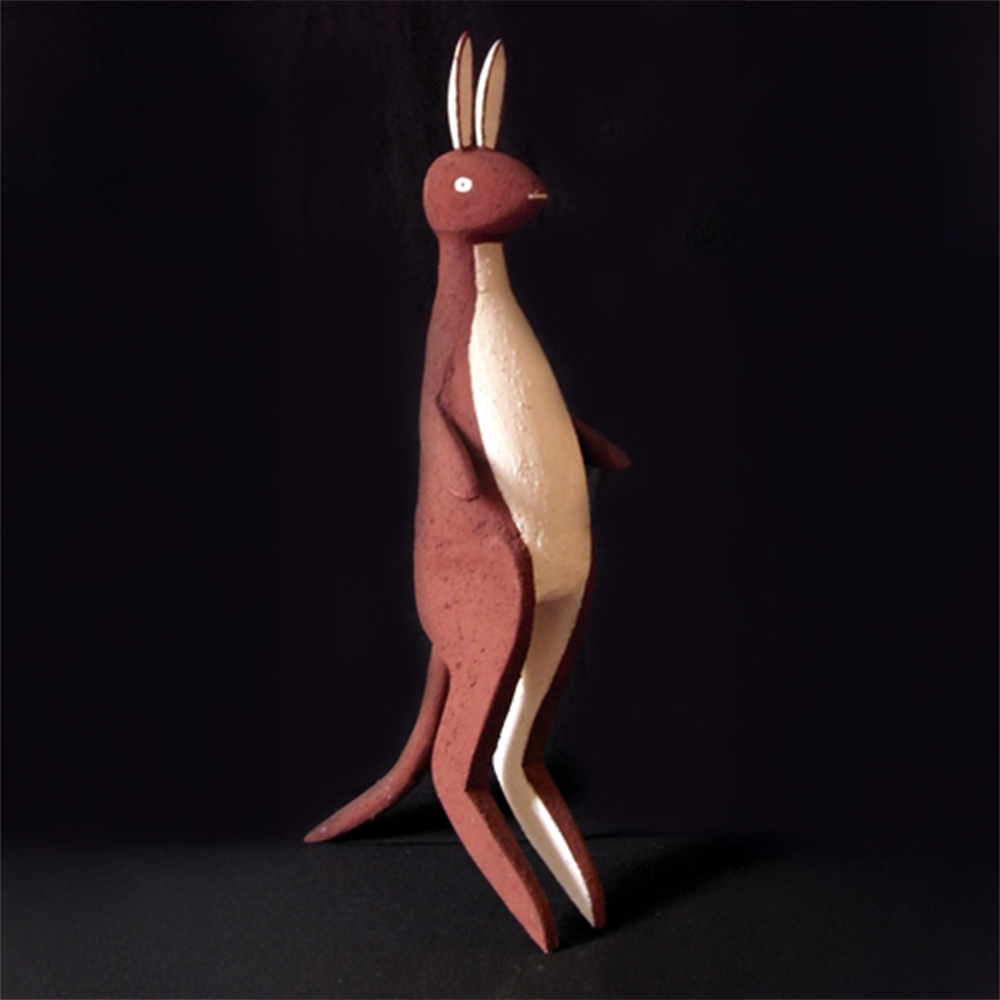
Artist: Steven Yunkaporta| Title: Wallaby | Year: 2006 | Medium: synthetic polymer paint and ochres on milkwood | Dimensions: 75 x 46 x 24 cm
PROVENANCE
Wik and Kugu Art Centre, Aurukun
ARTWORK STORY
At the tip of tropical far north Queensland the Aurukun mission was presided over by the all-powerful Presbyterian superintendent, William MacKenzie, from 1923 to 1965. The son of Canadian Missionaries born in Vanuatu, MacKenzie was a contradictory character who underwent initiation as well as learning the local language. But he actively isolated the Wik and Kugu inhabitants from the people living along the coastline of the Gulf of Carpentaria. The remaining clans did not settle at Aurukun, Weipa and Edward River missions until the late 1940s during World War II.
By the 1950s and 1960s, Aurukun sculptors were creating innovative sculptures by introducing a variety of materials including resin, beeswax, horsehair, leather, bark, glass beads and plastic buttons to wood and clay figures. Under the supervision of the mission carpenter Jock Henderson crocodiles, turtles, sharks, human figures, and snakes as well as spears, boomerangs and artefacts, were carved from local timbers. They featured attached or inlaid limbs, teeth, breasts, fins, and eyeballs. As this artistic tradition developed the sculptors of Aurukun gained more respect and notoriety especially following important re-enactments of ceremonies, which were masterminded by MacKenzie in 1958 and 1962, who also arranged for these spectacular dances to be filmed for the Australian institute of Aboriginal Studies by Ian Dunlop, Fred McCarthy and Peter Hilton. It was a brilliant public relations exercise for Aurukun culture, winning friends in Canberra, and allowing MacKenzie to retire in 1965 with the ceremonial traditions recorded for posterity.
PROVENANCE
Wik and Kugu Art Centre, Aurukun
ARTWORK STORY
At the tip of tropical far north Queensland the Aurukun mission was presided over by the all-powerful Presbyterian superintendent, William MacKenzie, from 1923 to 1965. The son of Canadian Missionaries born in Vanuatu, MacKenzie was a contradictory character who underwent initiation as well as learning the local language. But he actively isolated the Wik and Kugu inhabitants from the people living along the coastline of the Gulf of Carpentaria. The remaining clans did not settle at Aurukun, Weipa and Edward River missions until the late 1940s during World War II.
By the 1950s and 1960s, Aurukun sculptors were creating innovative sculptures by introducing a variety of materials including resin, beeswax, horsehair, leather, bark, glass beads and plastic buttons to wood and clay figures. Under the supervision of the mission carpenter Jock Henderson crocodiles, turtles, sharks, human figures, and snakes as well as spears, boomerangs and artefacts, were carved from local timbers. They featured attached or inlaid limbs, teeth, breasts, fins, and eyeballs. As this artistic tradition developed the sculptors of Aurukun gained more respect and notoriety especially following important re-enactments of ceremonies, which were masterminded by MacKenzie in 1958 and 1962, who also arranged for these spectacular dances to be filmed for the Australian institute of Aboriginal Studies by Ian Dunlop, Fred McCarthy and Peter Hilton. It was a brilliant public relations exercise for Aurukun culture, winning friends in Canberra, and allowing MacKenzie to retire in 1965 with the ceremonial traditions recorded for posterity.





